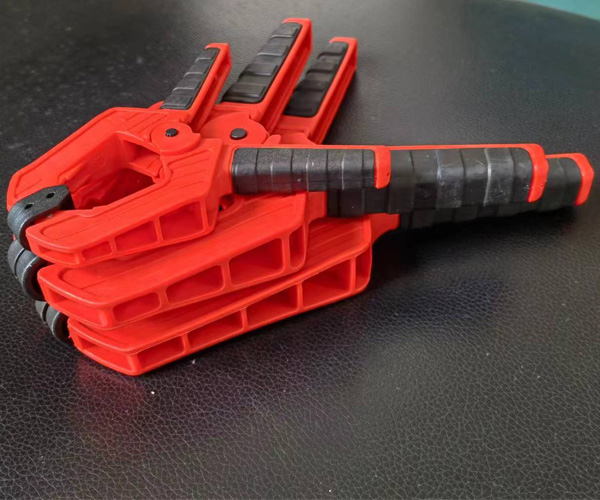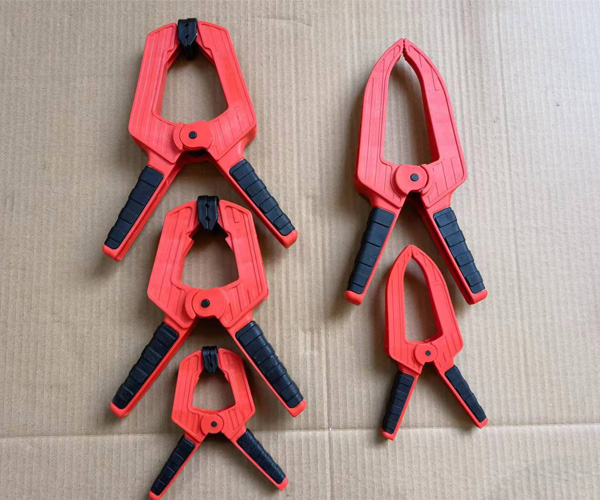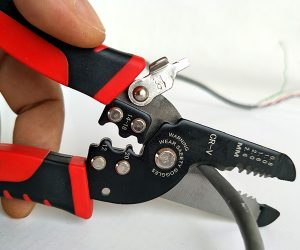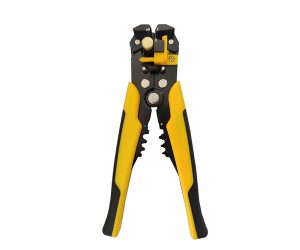In this article, we’ll explore the fascinating world of spring clamps—what they are, how they work, and the many uses they have in various industries. Whether you’re a professional in the woodworking, automotive, or DIY industries, understanding how spring clamps can improve your workflow is essential. We’ll dive deep into the types, features, and applications of these versatile tools, as well as how to choose the right one for your project. So, let’s get started!
1. What is a Spring Clamp?
Spring clamps are simple but highly effective tools designed to apply pressure and hold materials together. Their structure includes two arms, a spring mechanism, and a handle that allows the user to easily apply force. But here’s the kicker—while the design is simple, the variety and effectiveness of spring clamps are vast. They are often used in situations where a temporary but strong hold is required.
To begin with, spring clamps are typically made of either plastic or metal, with the metal varieties being stronger and more durable. The spring mechanism is what gives these clamps their power—when you squeeze the handles, the jaws of the clamp open, and when you release the handles, the spring force holds the jaws tightly shut. This makes spring clamps especially useful in woodworking, automotive, and crafting tasks.
Spring clamps come in various sizes, designed for different applications. Smaller versions might be perfect for delicate tasks like gluing fine materials, while larger models can handle heavy-duty work like securing parts in car repairs. The flexibility and ease of use make spring clamps an essential tool in any workspace.
| Type of Spring Clamp | Material | Typical Use |
|---|---|---|
| Small Plastic Clamp | Plastic | DIY, Crafting |
| Medium Metal Clamp | Metal | Woodworking, Automotive |
| Large Heavy-Duty Clamp | Metal | Industrial, Heavy-duty |
2. How Do Spring Clamps Work?
What’s the real story behind how spring clamps work? Let’s break it down. Spring clamps are designed with a unique mechanism that uses a spring to apply pressure to the workpiece. The force is created by the tension in the spring, which works when you squeeze the handles together.
In more technical terms, the spring clamp’s mechanism operates under a principle known as a “spring-loaded force.” When the handles are squeezed, the clamp jaws open, allowing you to position them around the object. Once the handles are released, the spring tension forces the jaws to close tightly, holding the object in place. The beauty of this design is that the clamp can be operated with one hand, making it incredibly convenient for various tasks.
The functionality of the spring clamp makes it ideal for quick and temporary fastening. For instance, if you are working with wood, you can quickly secure the pieces together while the glue sets, without worrying about the material slipping. What’s more, the design of spring clamps allows them to be used in tight spaces, offering a significant advantage over other types of clamps.
| Feature | Spring Clamps | C-Clamps | Bar Clamps |
|---|---|---|---|
| Ease of Use | High | Moderate | Low |
| Space Efficiency | High | Low | Moderate |
| Holding Strength | Moderate | High | High |
3. What Are the Main Features of Spring Clamps?
Ready for the good part? Let’s explore the features that make spring clamps so versatile. Spring clamps are known for their simple, yet highly functional design. A typical spring clamp features a pair of arms that are hinged at the center, with a strong spring that causes the arms to exert pressure when the handles are released.
The jaws of a spring clamp are usually coated with a non-slip material, which is especially important when working with delicate surfaces like wood or plastic. This feature ensures a secure grip without damaging the material. The handles are designed for comfort, allowing for extended use without causing hand fatigue. Additionally, the spring tension is designed to be strong enough to hold materials firmly in place, yet not so strong that it’s difficult to release.
Another standout feature of spring clamps is their portability. These clamps are lightweight and easy to store, making them perfect for both professionals and DIYers who need a tool that doesn’t take up much space. Moreover, many spring clamps are designed with safety in mind, featuring easy-release mechanisms that allow for quick disengagement.
| Feature | Description |
|---|---|
| Non-Slip Jaws | Prevents damage to materials |
| Comfortable Handles | Designed for extended use |
| Lightweight Design | Easy to carry and store |
| Safety Release Mechanism | Quick and safe disengagement |
4. What Are the Different Types of Spring Clamps?
What types of spring clamps exist? Let’s dive into the various types, as different tasks require different kinds of clamps. First, we have plastic spring clamps. These are lighter and less expensive, making them ideal for light-duty work. They are often used for crafting, small repairs, and light woodworking.
Metal spring clamps are the next category. These are more durable and stronger, often used for more demanding tasks such as automotive work or heavy-duty woodworking. Some metal spring clamps even feature rust-resistant coatings for added durability in harsher environments.
Lastly, there are heavy-duty spring clamps, which are designed for industrial applications. These clamps are much larger, often featuring enhanced springs to provide extra holding power. They are perfect for larger materials or high-stress environments where a standard spring clamp might not be enough.
| Clamp Type | Material | Size | Ideal Use |
|---|---|---|---|
| Small Plastic Clamp | Plastic | Small | DIY, Crafting |
| Medium Metal Clamp | Metal | Medium | Woodworking, Automotive |
| Heavy-Duty Clamp | Metal | Large | Industrial, Heavy-Duty |

5. What Are the Common Applications of Spring Clamps?
What’s the real application of a spring clamp in your day-to-day work? Spring clamps are incredibly versatile tools used in a wide range of industries. In woodworking, they are invaluable for holding pieces together while glue sets. This makes them essential for both fine furniture making and basic woodworking projects.
In the automotive industry, spring clamps play a critical role in securing hoses and other components during repairs. The ability to quickly apply pressure without requiring extra tools makes them ideal for fast-paced mechanical work.
Spring clamps are also indispensable in the DIY community. Whether it’s holding materials while painting, securing fabric for crafting, or keeping parts together during small repairs, the uses are practically endless. Ready for the good part? With just one tool, you can tackle countless tasks that would otherwise require multiple tools.
| Industry | Common Use Case | Clamp Size |
|---|---|---|
| Woodworking | Holding wood while gluing | Small |
| Automotive | Securing hoses during repairs | Medium |
| DIY Projects | Holding materials while painting | Small |
6. How to Choose the Right Spring Clamp for Your Project?
This is where it gets interesting—choosing the right spring clamp isn’t as simple as picking the first one you see. The right spring clamp for your project depends on several factors, including the material you’re working with, the size of the object, and the amount of force needed.
First, consider the size of the clamp. For smaller tasks, a small plastic spring clamp might do the job. However, for larger projects or more heavy-duty work, you might need a larger metal clamp to ensure the clamp can hold the material securely. Second, consider the material of the clamp. While plastic clamps are lightweight, they may not provide the strength you need for more demanding tasks. Metal clamps, on the other hand, are more durable and offer a stronger grip.
Finally, consider the spring strength. Some projects may require a higher tension, such as when holding large or heavy materials. In this case, a heavy-duty spring clamp would be ideal.
| Consideration | Small Clamp | Medium Clamp | Heavy-Duty Clamp |
|---|---|---|---|
| Size | Light tasks | General work | Heavy-duty tasks |
| Material | Plastic | Metal | Metal |
| Spring Strength | Low | Moderate | High |
7. What Are the Advantages of Using Spring Clamps?
Why should you bother with spring clamps? The advantages are significant! First and foremost, spring clamps are incredibly efficient. Their spring-loaded mechanism allows for fast application and removal, saving you time when working on a project. This makes them especially useful in professional settings where time is a factor.
Spring clamps also provide a high degree of accuracy. The tension created by the spring ensures that the materials are held firmly in place, reducing the likelihood of shifting or slipping. This is particularly important in precise tasks like woodworking or car repairs.
Lastly, the portability of spring clamps is a huge benefit. Unlike large, bulky clamps, spring clamps are lightweight and easy to carry around. Whether you’re working in your garage or transporting them between job sites, they take up minimal space and are easy to store.
| Advantage | Description |
|---|---|
| Time Efficiency | Quick application and removal |
| Accuracy | Strong, secure hold |
| Portability | Lightweight and easy to store |
8. How Do Spring Clamps Compare to Other Clamps?
This is where it gets interesting—spring clamps have a unique place in the world of clamping tools. Let’s compare them to other types of clamps to see how they stack up.
When it comes to ease of use, spring clamps are unrivaled. Unlike C-clamps or bar clamps, which require multiple steps to apply, spring clamps can be used with one hand, making them much faster to apply and release. However, in terms of holding power, C-clamps and bar clamps may have the upper hand. If you need a clamp that can hold a heavy-duty material with immense pressure, a bar clamp would likely outperform a spring clamp.
Still, for everyday tasks, spring clamps are an excellent choice. They offer a balance of ease and holding strength that makes them a popular choice among professionals and DIYers alike.
| Clamp Type | Ease of Use | Holding Power | Ideal Use |
|---|---|---|---|
| Spring Clamp | High | Moderate | DIY, Light Work |
| C-Clamp | Low | High | Heavy Duty Work |
| Bar Clamp | Low | Very High | Woodworking |
9. How to Use a Spring Clamp Correctly?
What’s the real story behind using a spring clamp? It’s simple, really. First, position the clamp around the materials you want to secure. Squeeze the handles to open the jaws, then release to apply pressure. Ensure that the clamp is positioned properly to avoid damaging the material.
While using a spring clamp might seem straightforward, there are a few tips to keep in mind. For one, make sure the clamp is sized appropriately for your project. A clamp that’s too small may not apply enough pressure, while one that’s too large might be difficult to use in tight spaces.
What’s more, be careful not to overtighten the clamp. Although the spring mechanism provides a strong hold, applying too much pressure can damage delicate materials.
| Step | Action | Tips |
|---|---|---|
| Step 1 | Open the clamp | Position it properly |
| Step 2 | Place the clamp on the material | Ensure appropriate size |
| Step 3 | Release the handles to secure the clamp | Don’t overtighten |
10. What Are the Maintenance Tips for Spring Clamps?
So, you’ve got your spring clamps, but how do you keep them in top condition? Proper maintenance is key to ensuring that your clamps last for years. Start by cleaning the clamps after each use, especially if they come into contact with glue, paint, or other debris. A quick wipe-down can prevent buildup that might affect performance.
Next, make sure the spring is functioning properly. If you notice that the clamp isn’t holding as tightly as it should, it might be time to replace the spring or lubricate the mechanism to ensure smooth operation.
Lastly, store your clamps in a dry, cool place. Storing them in a humid or damp environment could lead to rusting, especially in metal clamps. Proper care and storage can extend the life of your spring clamps and keep them functioning at their best.
| Maintenance Tip | Action |
|---|---|
| Clean After Use | Wipe down to remove debris |
| Check Spring Tension | Lubricate or replace the spring if needed |
| Proper Storage | Store in a dry, cool environment |
11. How Durable Are Spring Clamps?
How long do spring clamps last? The durability of a spring clamp largely depends on the material it’s made from. Metal spring clamps, particularly those made of stainless steel or heavy-duty alloys, tend to have a longer lifespan than plastic clamps. Additionally, spring tension and overall build quality affect their durability.
While plastic clamps may not last as long as metal clamps, they can still be reliable for light to moderate tasks. The key to longevity lies in proper care. By ensuring that the clamps are cleaned and stored correctly, you can significantly extend their service life.
| Material | Durability | Ideal Use |
|---|---|---|
| Plastic | Moderate | DIY, Light Use |
| Metal | High | Heavy Duty Work |
12. Are Spring Clamps Safe to Use?
Spring clamps are generally safe to use, but like all tools, they come with their precautions. The most important thing to keep in mind is that the spring mechanism can cause the clamp to snap shut with force. When applying or removing the clamp, always ensure that your hands are clear of the jaws.
For additional safety, use spring clamps with non-slip handles, which can help you maintain control while operating the tool. If you’re using a spring clamp on delicate materials, ensure that the jaws are lined with protective coatings to avoid damage.
| Safety Tip | Description |
|---|---|
| Keep Hands Clear | Avoid placing hands near the jaws |
| Non-Slip Handles | Use clamps with ergonomically designed handles |
| Use Protective Jaws | Prevent damage to materials |
13. Where to Buy the Best Spring Clamps?
Ready for the good part? Finding high-quality spring clamps is easy if you know where to look. Major hardware stores, both physical and online, carry a wide variety of spring clamps. Some popular brands offer premium-quality clamps that are durable and reliable for both professionals and DIYers.
Online platforms like Amazon, Alibaba, and eBay offer a broad selection, including customer reviews to help guide your purchase. Whether you’re looking for small plastic clamps for light work or heavy-duty metal clamps for industrial tasks, there’s something for every need and budget.
| Platform | Type of Clamps Available | Price Range |
|---|---|---|
| Amazon | All types, from plastic to metal | $5 – $50+ |
| Alibaba | Bulk, OEM, various types | $2 – $40+ |
| eBay | New and used clamps | $3 – $45+ |
14. Can Spring Clamps Be Used for Heavy-Duty Work?
What’s the real story when it comes to heavy-duty work? While spring clamps are known for their versatility, standard models may not provide the clamping force required for the most demanding jobs. That said, heavy-duty spring clamps are available, designed specifically for use in industrial applications where high pressure and strong material grips are necessary.
These heavy-duty models typically feature stronger springs, more robust materials, and enhanced gripping surfaces, making them ideal for tasks such as construction, automotive repairs, and other professional uses.
| Heavy-Duty Clamp | Feature | Typical Use |
|---|---|---|
| Large Metal Clamp | Enhanced Spring Power | Industrial Work |
| Heavy Spring Clamp | Reinforced Design | Automotive Repair |

15. What Are Some Lesser-Known Uses for Spring Clamps?
Now, let’s talk about the lesser-known uses of spring clamps. Beyond the obvious tasks of woodworking and automotive repairs, spring clamps have a variety of unconventional uses. They can be used in photography to hold backdrops, secure cables, and even organize loose wires.
In the crafting world, spring clamps are indispensable for tasks such as securing fabric while sewing or holding intricate designs in place while glue dries. Their simplicity and ease of use make them a go-to tool in many settings.
| Use Case | Industry | Benefit |
|---|---|---|
| Photography | Photography | Hold backdrops |
| Electrical Work | Electrical Repair | Secure cables |
| Crafting | DIY | Hold designs in place |
Conclusion
In conclusion, spring clamps are incredibly versatile, easy-to-use tools that play a crucial role in various industries. From woodworking and automotive to DIY projects, the applications of spring clamps are numerous and varied. With the right knowledge and understanding of their features and uses, you can greatly enhance your work efficiency. Be sure to select the right type of clamp for your task, and always maintain them properly to ensure long-lasting use.
FAQ
Q1: What is a spring clamp?
A spring clamp is a tool designed to hold materials together, typically consisting of two arms with a spring mechanism that keeps the jaws clamped shut. They are used in a variety of tasks where a temporary, firm grip is needed.
Q2: How does a spring clamp work?
A spring clamp works by applying tension using a spring inside its body, which forces the jaws to stay clamped. The tension can be released by squeezing the handles together, which allows the clamp to be opened.
Q3: What are the different types of spring clamps?
Spring clamps come in various types, including plastic and metal variants, and are often specialized for certain tasks, such as larger clamps for heavy-duty uses or smaller ones for delicate work.
Q4: How do I maintain my spring clamps?
Proper maintenance involves cleaning your spring clamp regularly, ensuring it is free of dirt or rust, and storing it in a dry place to prolong its lifespan. Periodically check the tension of the spring to ensure it’s working effectively.
Q5: Can I use spring clamps for woodworking?
Yes, spring clamps are commonly used in woodworking. They help hold pieces of wood together while gluing or during assembly, providing a strong temporary grip that allows for precision without damage.




